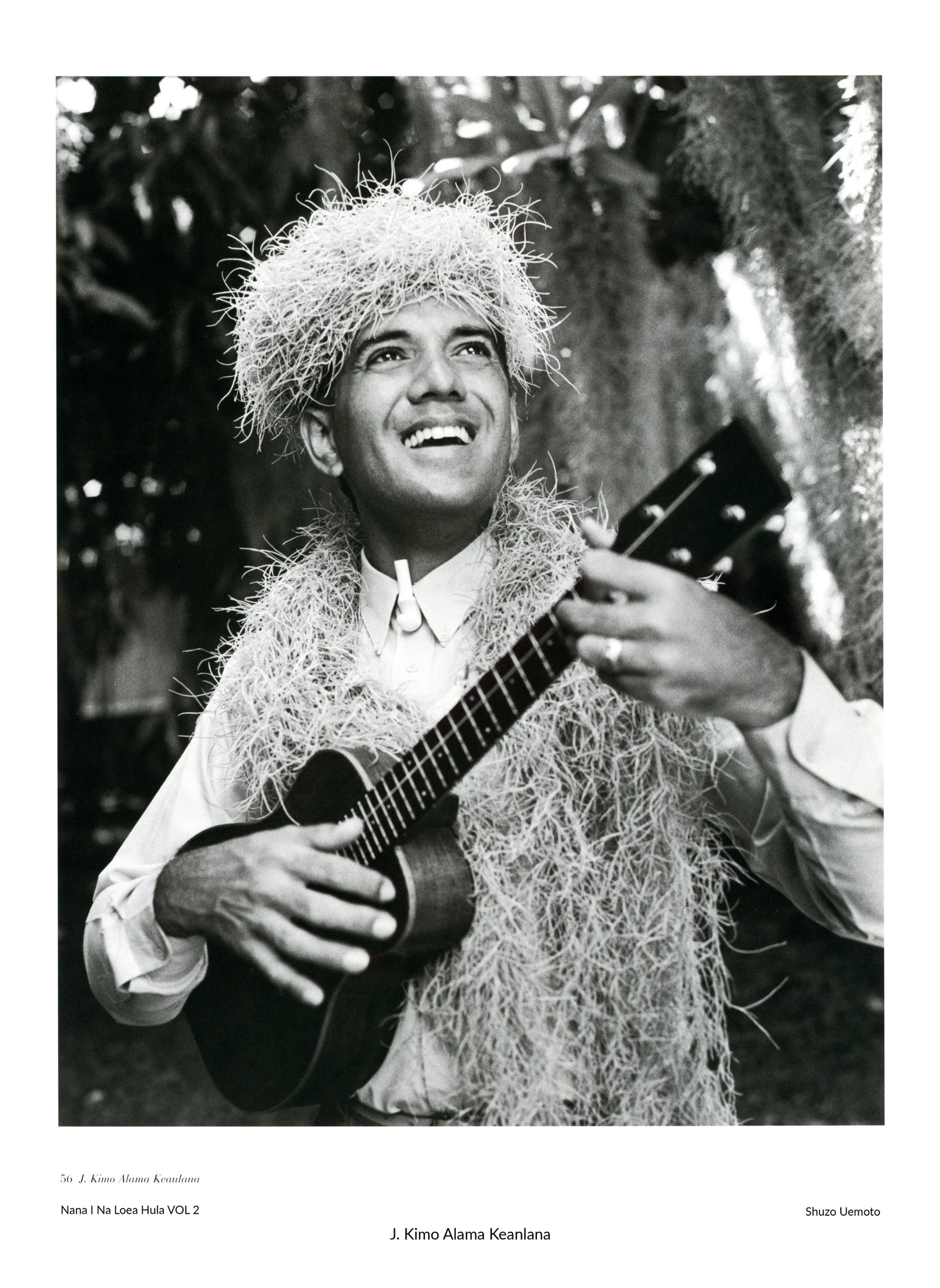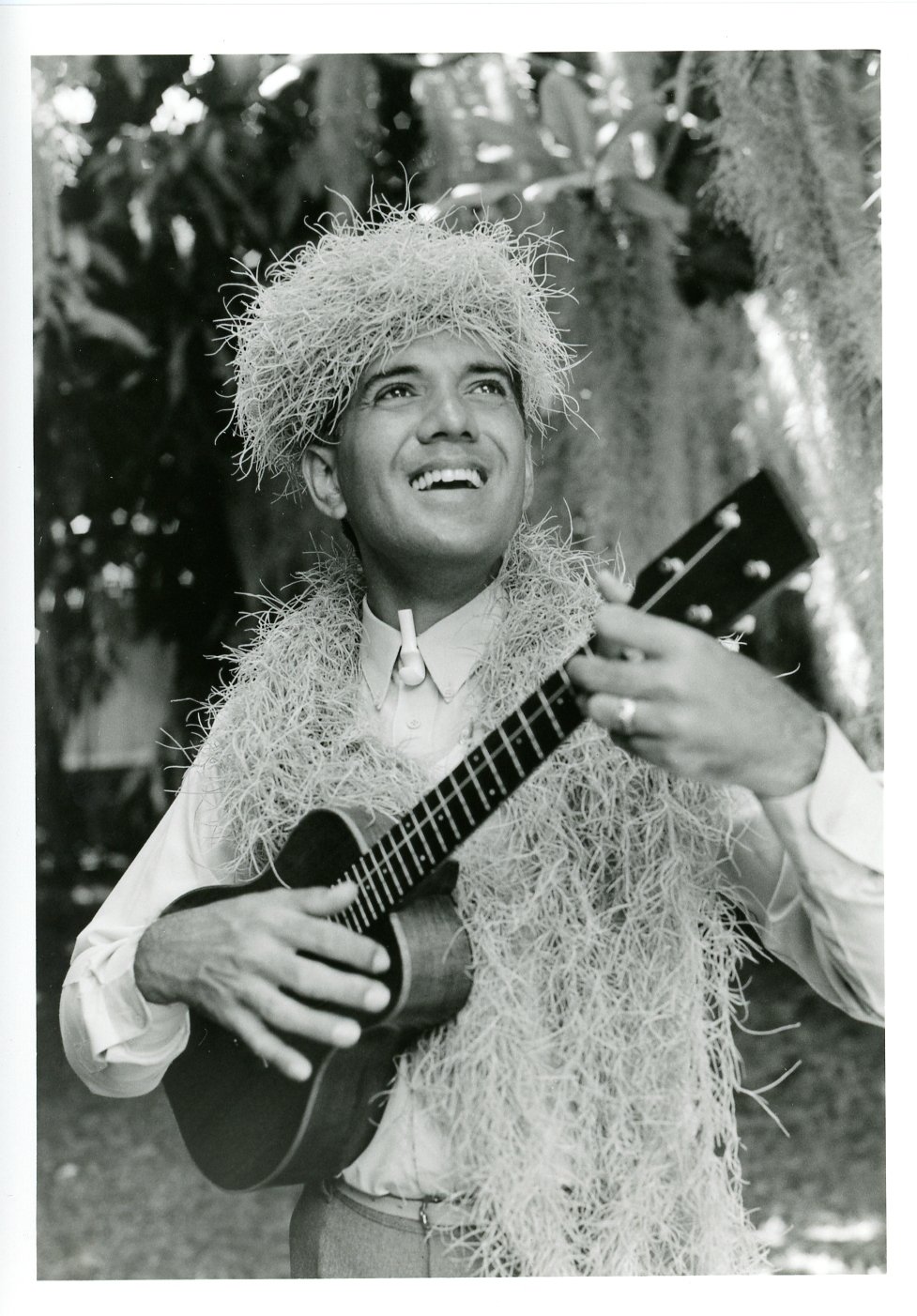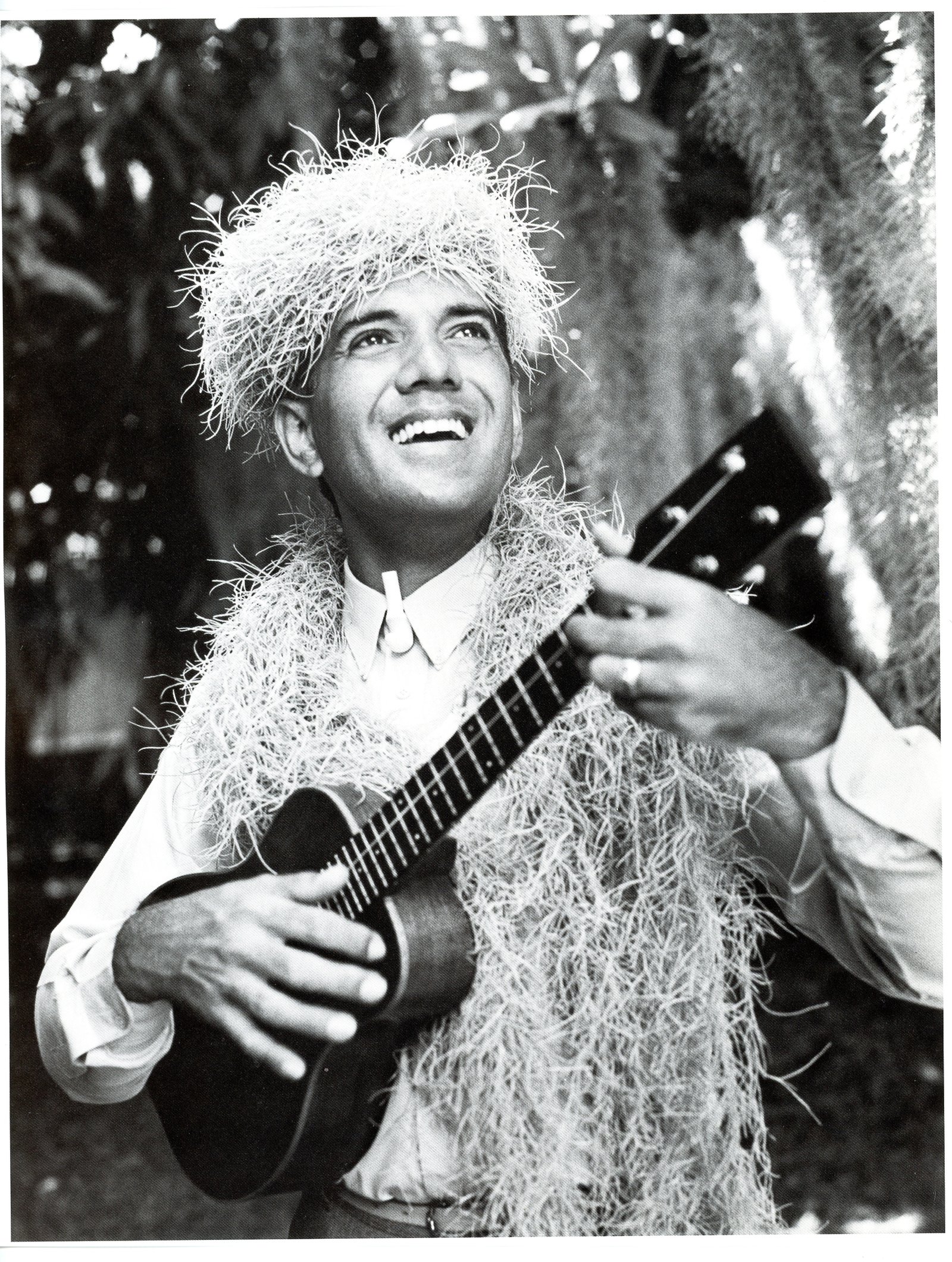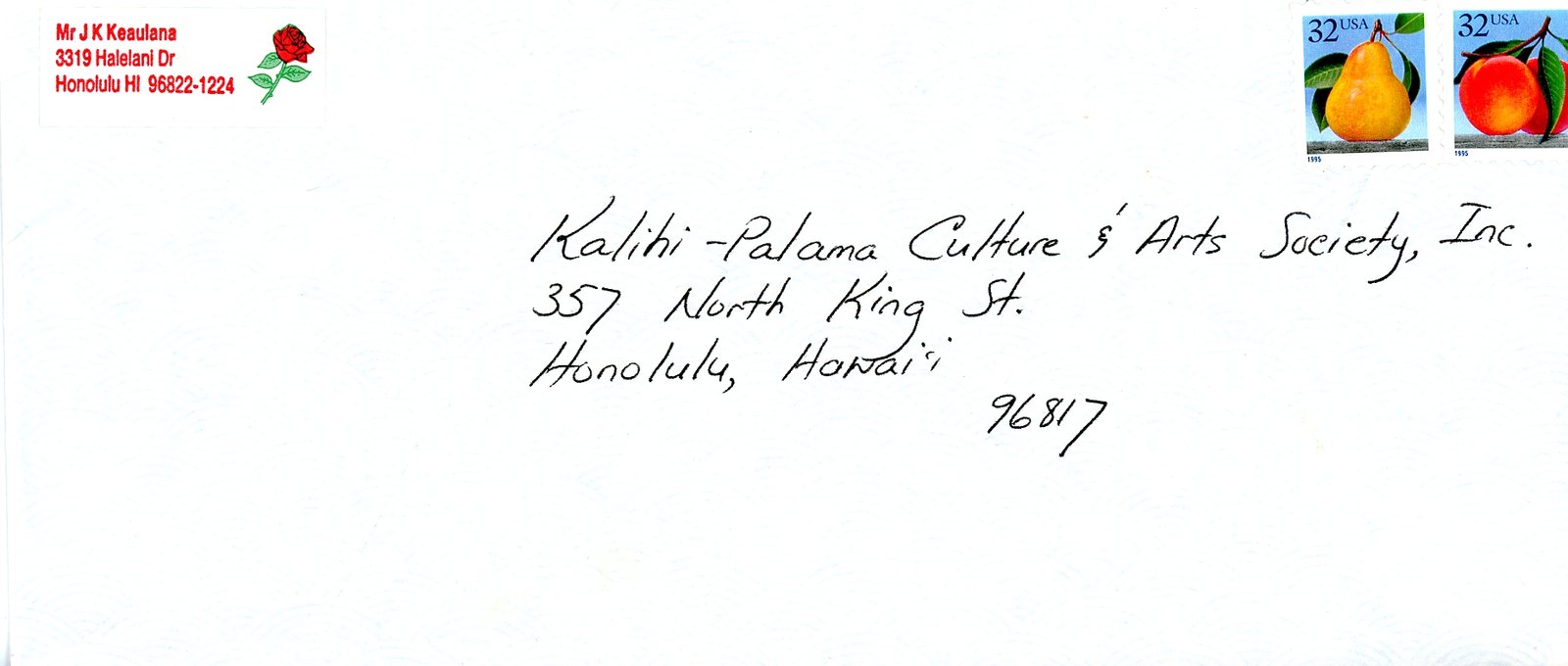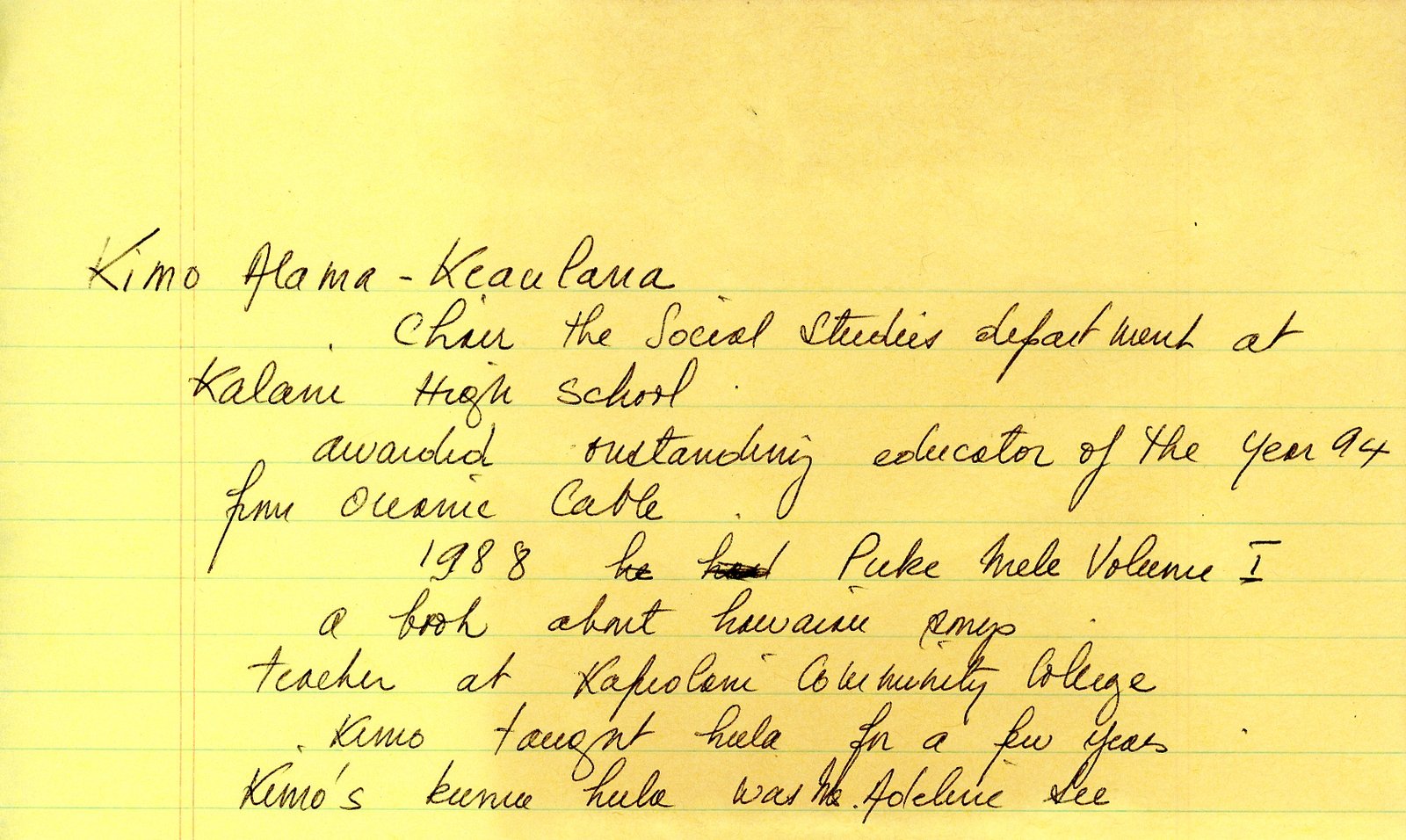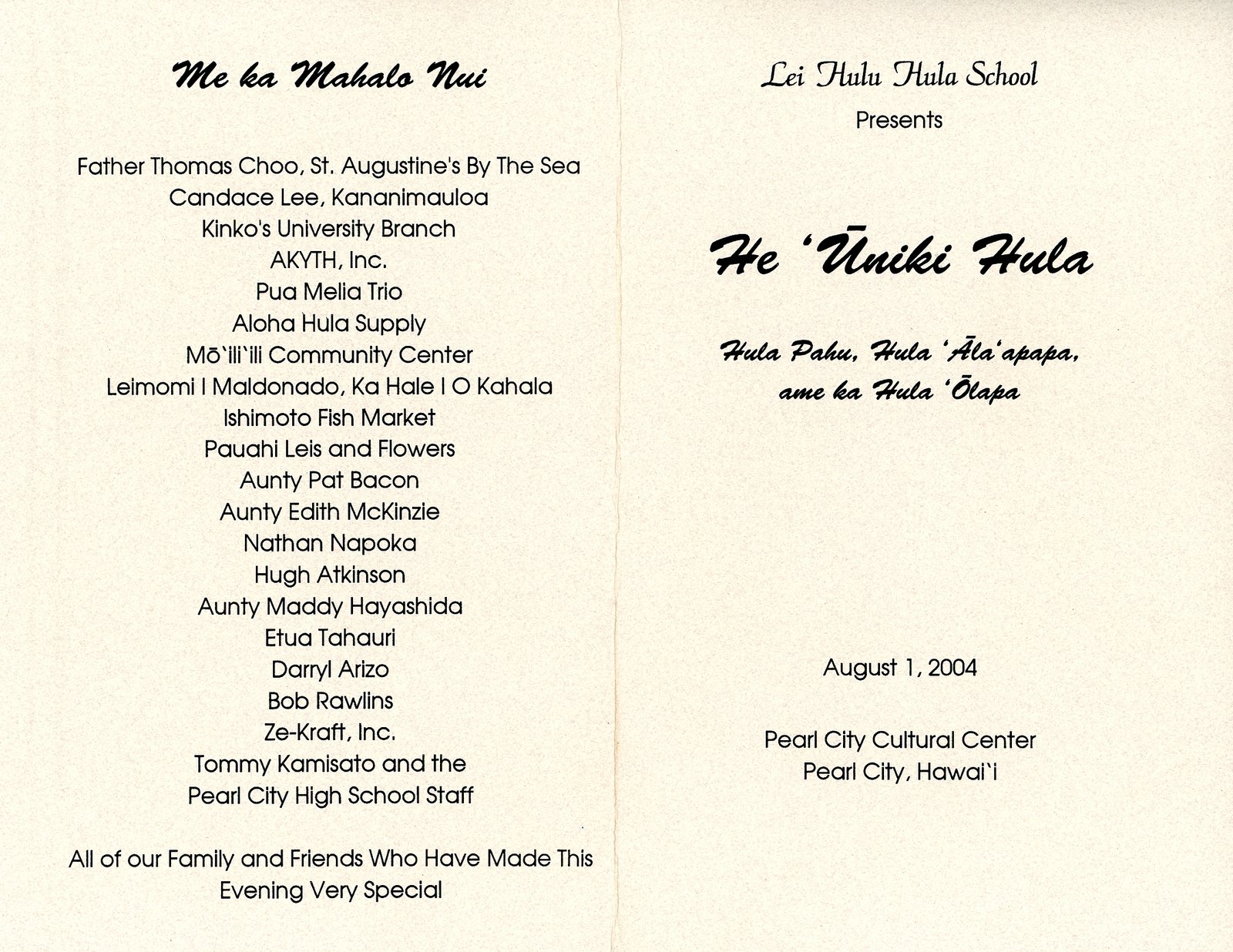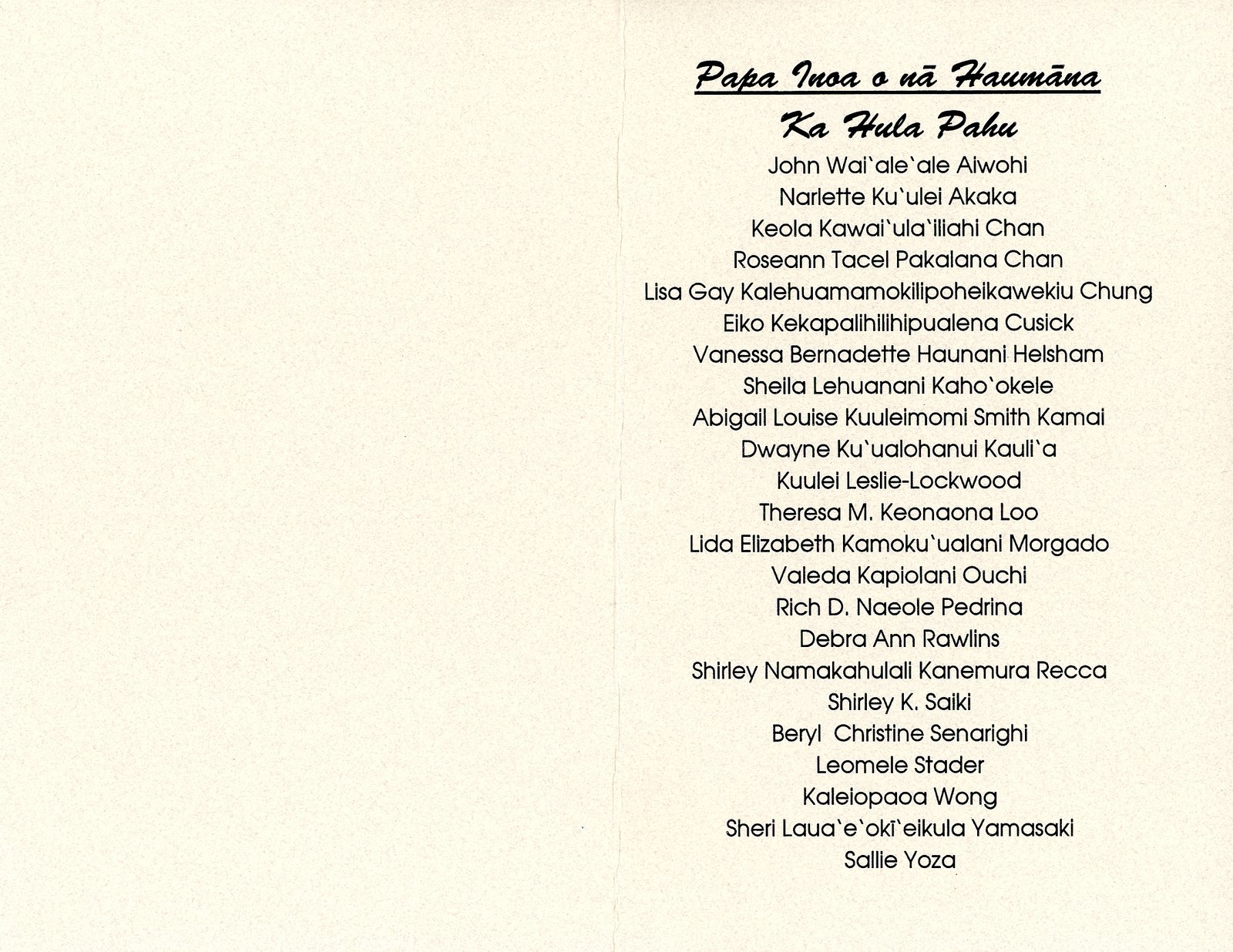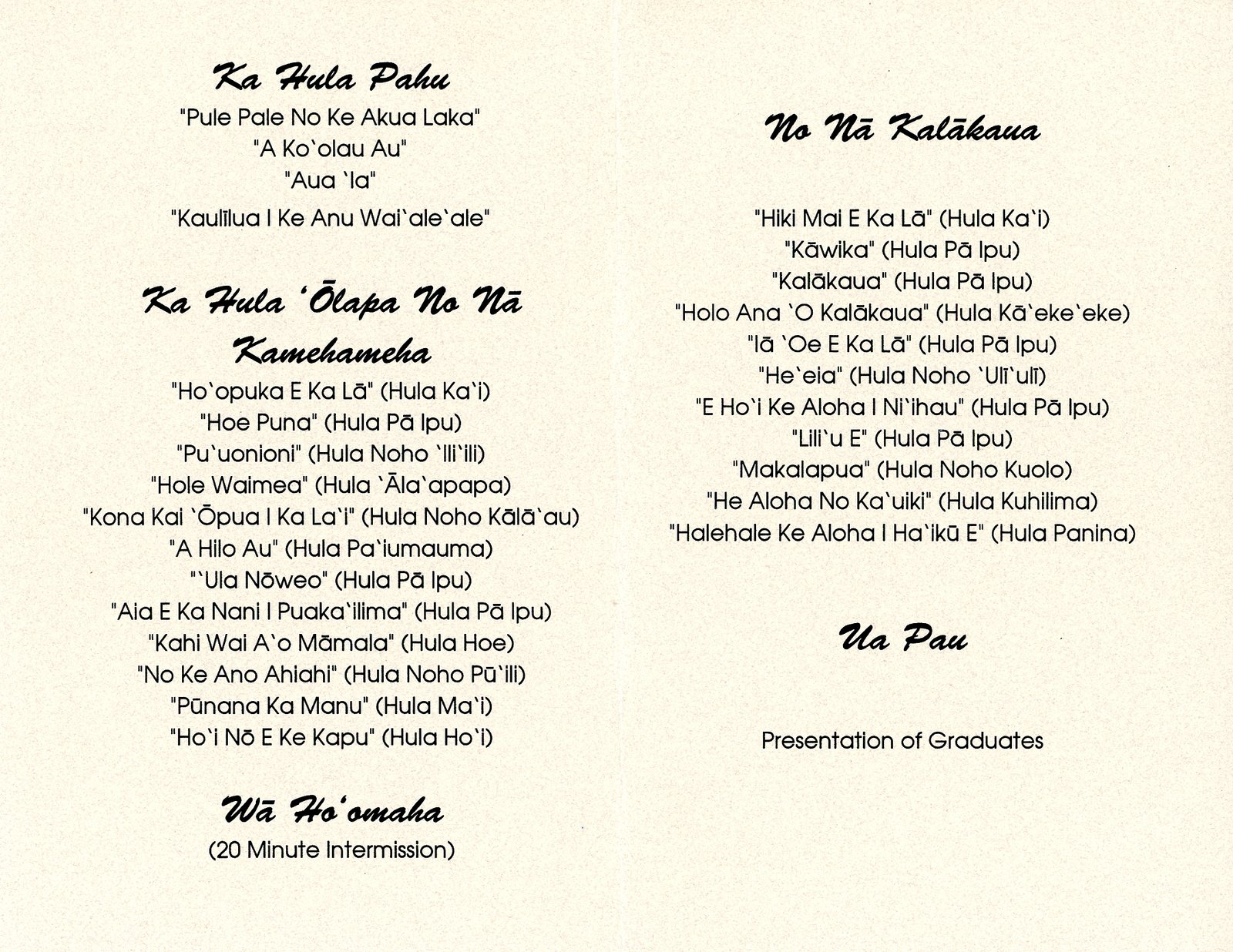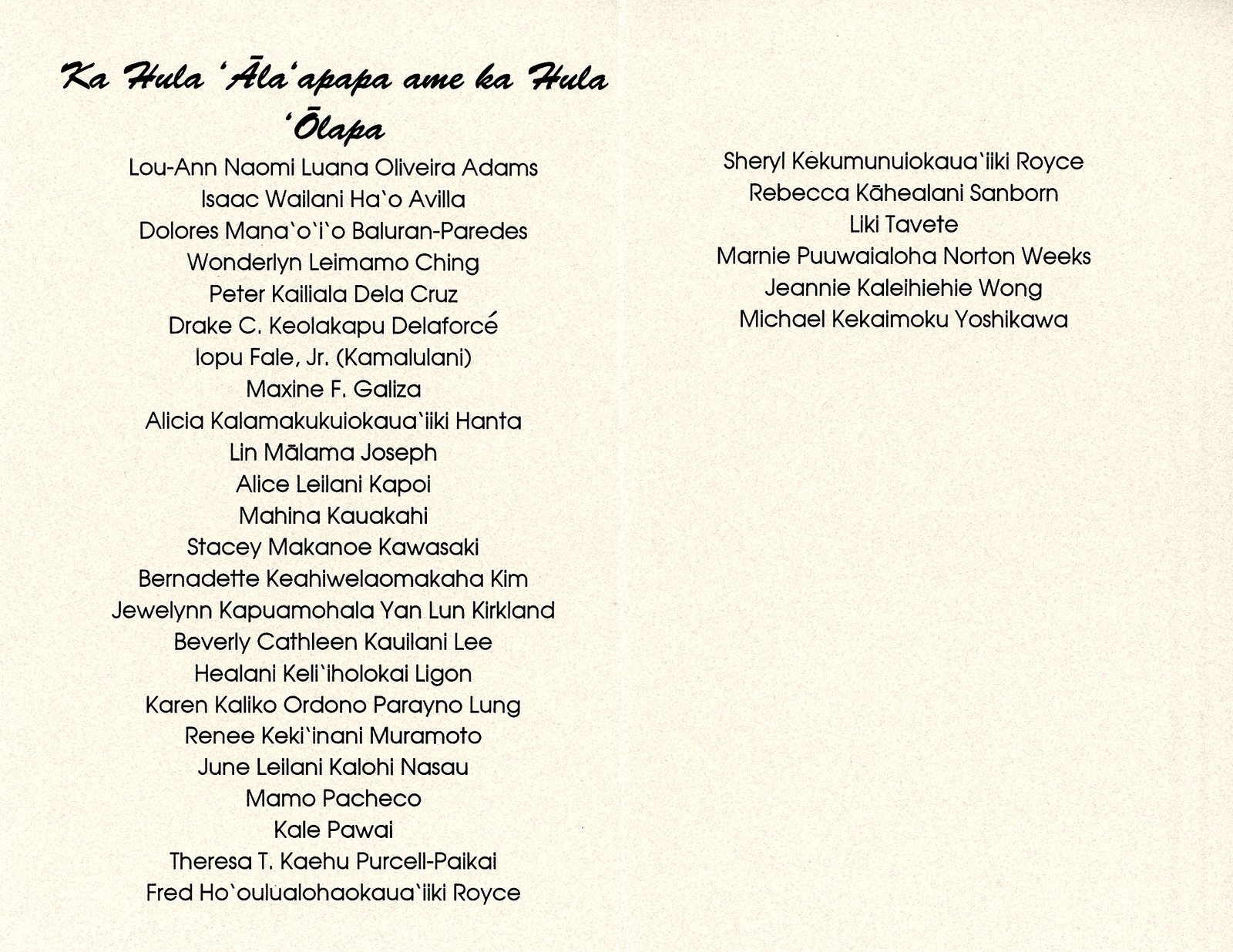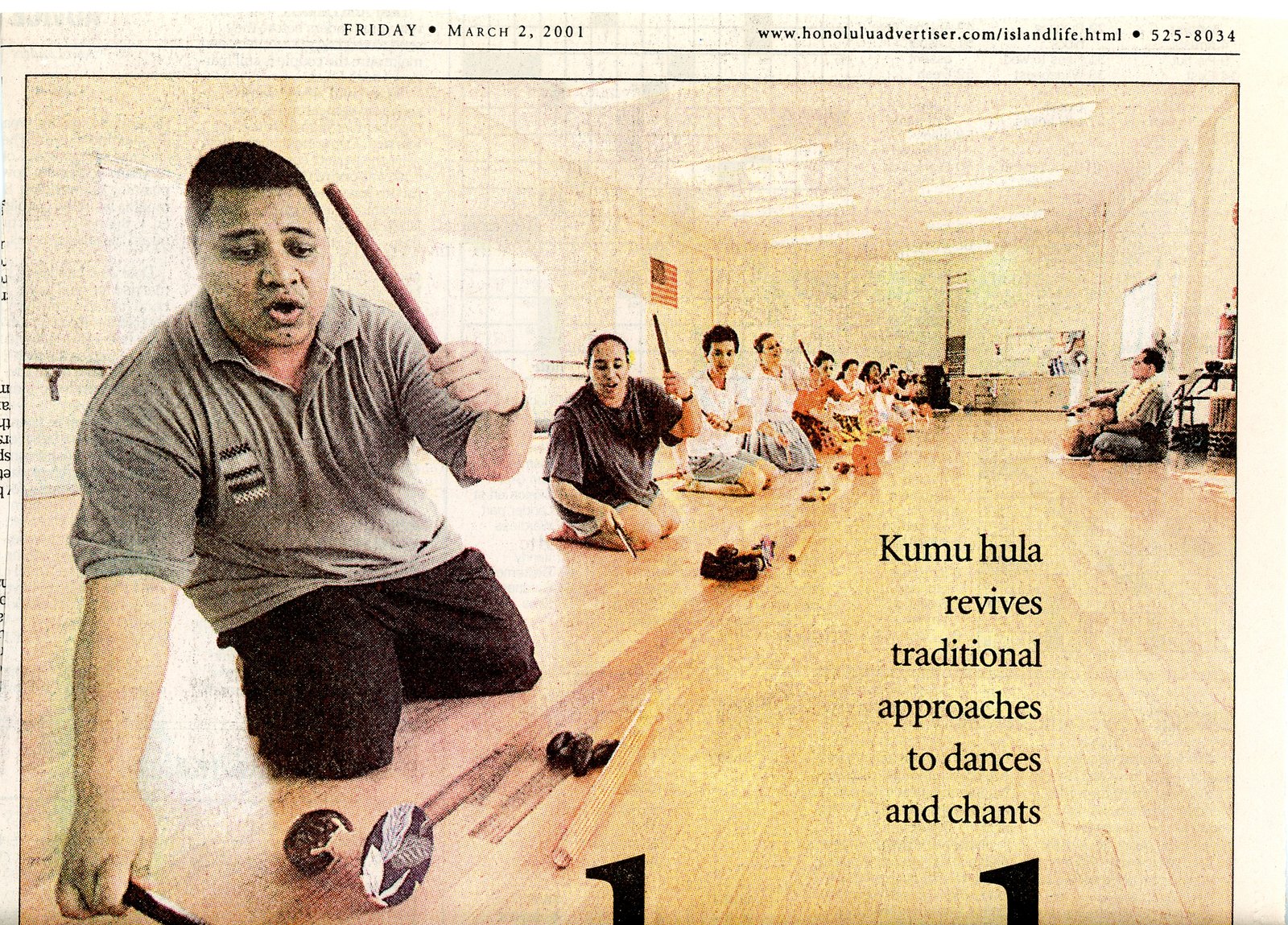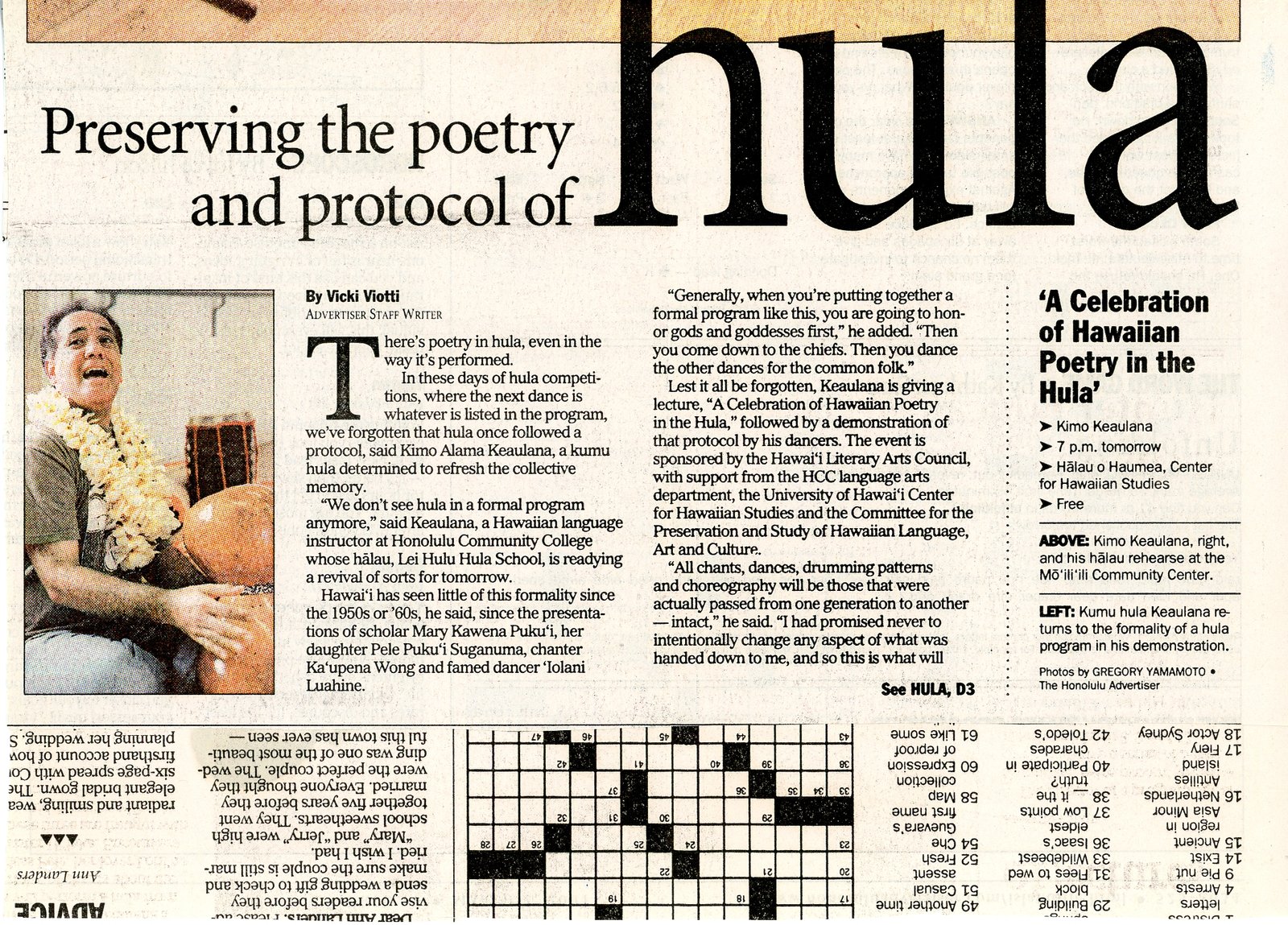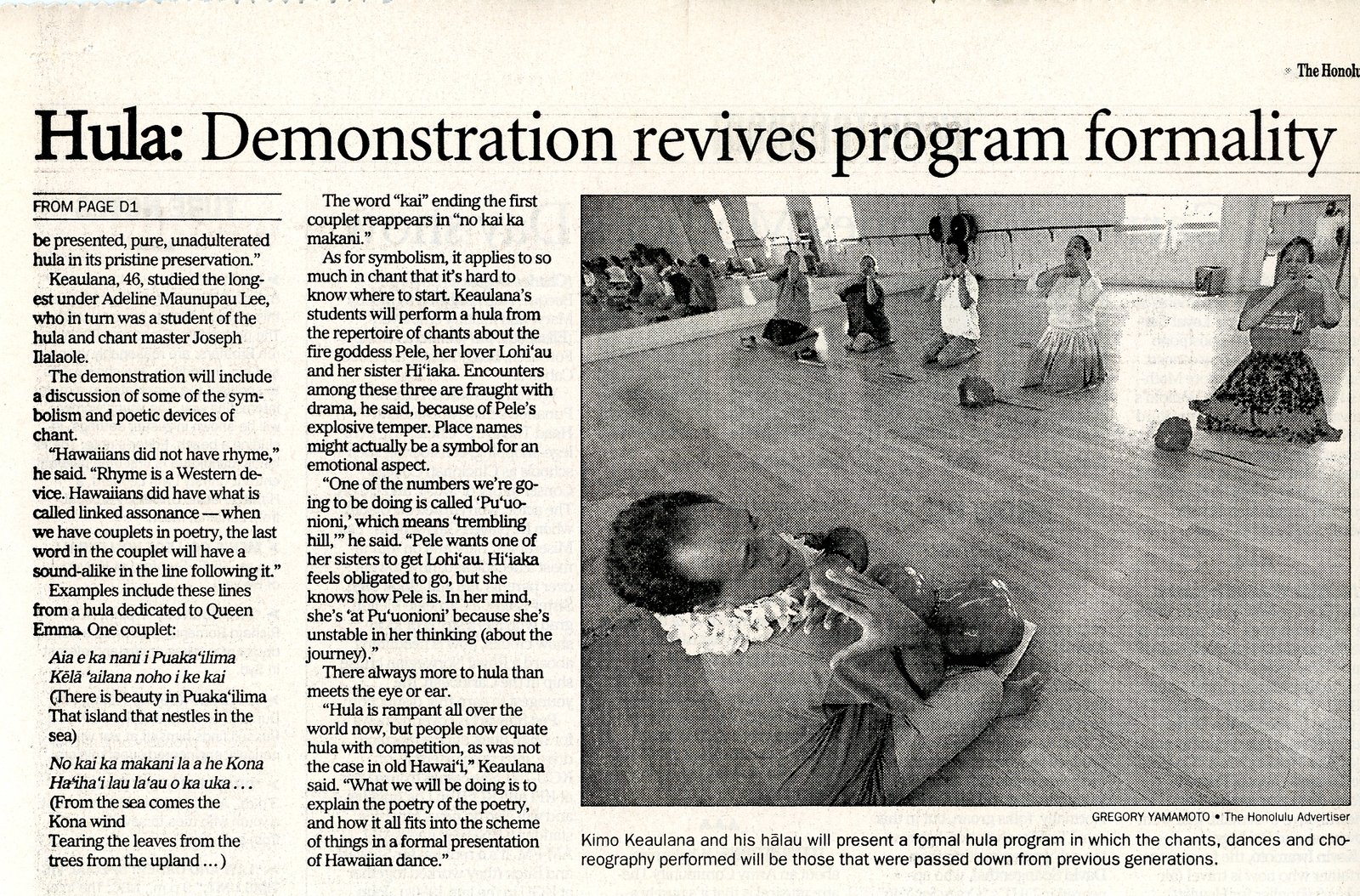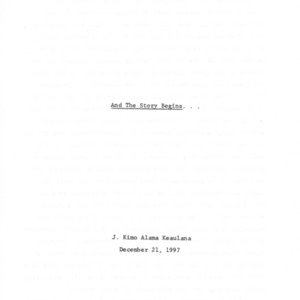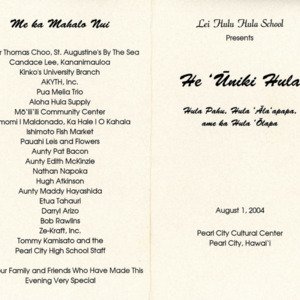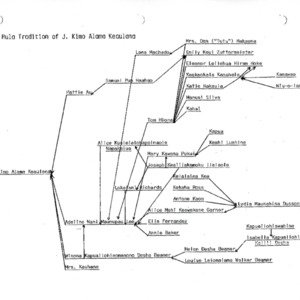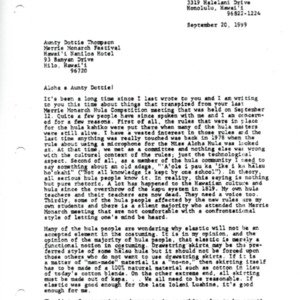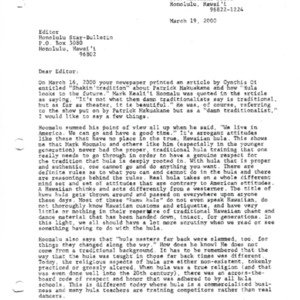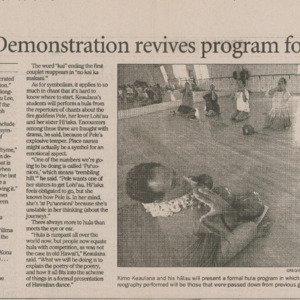J. Kimo Alama Keaulana
Title
J. Kimo Alama Keaulana
Subject
Nā Kumu Hula J. Kimo Alama Keaulana - Nānā I Nā Loea Hula Volume 2 Page 57
Description
Kimo Alania Keaulana is currently a Hawaiian Studies instructor at the Honolulu Community College and runs the Lei Hula Hula School in Waimea, Kaua‘i and Honolulu, O‘ahu.
When I was small, my mother did not want me to have anything to do with hula because in the 1960s only girls danced hula. If you danced hula when you were young, it was said that you would grow up to be māhū. But hula seemed natural for me. It didn't tell anybody that I was taking hula. Not even my mother knew.
The first time I danced hula was at the age of three-years-old. I used to watch my mother and my older sisters take hula lessons from Mrs. Adeline Bee at the Mānoa Playground. When I was nine, I accompanied my younger sister to her hula classes and I was invited to sing with the other children. Aunty Adeline saw that I was interested and she let me assist her by carrying her 'ukulele and other things. Later Aunty Adeline took me to her other hula classes at the different playgrounds. I learned how to play the ‘ukulele, how to phrase Hawaiian words in chanting and singing, and I learned pronunciation. I learned to be a ho‘opa‘a first.
I was with Aunty Adeline for fourteen years as a student and apprentice. I assisted her when she had to give workshops. She was a beautiful singer but she always told us that she did not chant very well. So I handled the chanting and the heavy drumming for her.
I had just turned sixteen when Aunty Adeline went to Japan and left me in charge of her hula classes for the Parks and Recreation. I guess she would not have done so if she thought I couldn't do it. So I taught at least a hundred kids for the summer program.
I also went to Mrs. Hattie Au off and on for about a year while she was living in Kahana. She was Pua Ha‘aheo’s alaka‘i and she was a very old woman at the time I learned hula from her. After Mrs. Au, Ms. Kauhane was my teacher for about two years. They both taught drumming, chanting, and ancient dancing. While attending the Kamehameha Schools from 1969 to 1973, I also learned and worked with Ms. Winona Beamer.
In 1969 Aunty Hoakalei Kamauʻu conducted hula workshops for the State Foundation on Culture and the Arts. Out of a total of seventeen workshops, Aunty Adeline and I taught sixteen of them. Because of the large registration, Aunty Hoakalei asked Aunty Adeline if I could teach some classes on my own.
I did not have a formal ‘ūniki. Aunty Adeline and I were very strong Roman Catholics. At that time I made a decision in accordance with my beliefs but culturally I would not have minded going through a formal ‘ūniki ceremony. Aunty Adeline told me that I did not need any paper because in the old days they did not give any paper. Their teachers sanctioned them as teachers and I was sanctioned as such by my teacher.
In 1974, I needed extra money to buy a car so besides working at the Waikikian Hotel, I decided to teach hula on the side. Before I knew it, my friends sent their daughters and nieces, and soon I had forty students. I left my job to concentrate my energies on teaching hula full time. My hula studio grew and soon I had between two hundred to two hundred fifty students.
I was fortunate to have been surrounded by family members who practiced Hawaiian arts and crafts. Hula, music, lau hala weaving, feather lei making, Hawaiian quilting, Hawaiian medicine, implement making, and Hawaiian games were so much a part of my life. I was in my twenties when I discovered that other kids did not play Hawaiian games or weave or prepare lau hala. And when the Hawaiian renaissance came, there was such a hunger to learn the language. I was lucky because my maternal grandmother spoke Hawaiian to me and my teacher’s family and friends all spoke Hawaiian.
My advice to the younger hula teachers is to learn the language well because that is the most important tool of our trade. There is a difference between spoken language and poetic language. Not everybody has a command for poetry. A word can have multiple meanings. The composers of days gone by knew how to manipulate the language so well that they could express things that you could not take at face value. If you know the language well, you will know what they are saying. Some people call this “kaona.” We don’t see this in the composers of today. They try lint they do it superficially. “Kaona” is something that is very secretive and very subtle. And as a hula instructor you must know the language and what you are interpreting.
Hula is something that you cannot learn in just a few years. And just because you dance well, this is not enough for you to be a hula teacher. To be a teacher you must know the language. You must also know the drumming and (lie chanting. You cannot teach what you cannot do. If you want to teach modern hula, you must definitely know hula rhythm, patterns, beats, and different dance types. You must know how to play an ‘ukulele or at least play a guitar. You must know the names of places and about families for “mele inoa” and about the certain rains and winds. All the different places in Hawai‘i have their own personalities and characteristics.
Hula has changed drastically. The hula kahiko today is somehow misplaced. I appreciate the effort of people trying to create something that is in the traditional flavor. But there are beautiful dances that are traditional that I believe should never be rechoreographed or redone just because someone thinks it is boring. What comes from another time should stay in that time because it does not belong to us, it belongs to them. If someone gives you something, whether it be a song or a dance, you do that song or dance exactly the way you were taught because that belongs to them. Just like receiving a present all wrapped up and so pretty. You will treasure it, take care of it, not allow anybody to deface it.
We must look to our masters and not be afraid to acknowledge someone else as a master. That’s a part of humbling yourself. I don’t even call myself a kumu hula. I never use that title. I always call myself a hula instructor. If anybody needs my help, I will be glad to share. If I don’t know something, I will tell you that I don’t know.
Whatever came down from the past definitely affects our present and what we do in the present affects the future. Be proud of our Hawaiian culture and do not let any other cultures influence us. As much as possible keep our culture uniquely Hawaiian. If you are not sure, seek those who are knowledgeable and to do so very humbly. Always remember to be humble. That is the only way we can learn and pass it on.
When I was small, my mother did not want me to have anything to do with hula because in the 1960s only girls danced hula. If you danced hula when you were young, it was said that you would grow up to be māhū. But hula seemed natural for me. It didn't tell anybody that I was taking hula. Not even my mother knew.
The first time I danced hula was at the age of three-years-old. I used to watch my mother and my older sisters take hula lessons from Mrs. Adeline Bee at the Mānoa Playground. When I was nine, I accompanied my younger sister to her hula classes and I was invited to sing with the other children. Aunty Adeline saw that I was interested and she let me assist her by carrying her 'ukulele and other things. Later Aunty Adeline took me to her other hula classes at the different playgrounds. I learned how to play the ‘ukulele, how to phrase Hawaiian words in chanting and singing, and I learned pronunciation. I learned to be a ho‘opa‘a first.
I was with Aunty Adeline for fourteen years as a student and apprentice. I assisted her when she had to give workshops. She was a beautiful singer but she always told us that she did not chant very well. So I handled the chanting and the heavy drumming for her.
I had just turned sixteen when Aunty Adeline went to Japan and left me in charge of her hula classes for the Parks and Recreation. I guess she would not have done so if she thought I couldn't do it. So I taught at least a hundred kids for the summer program.
I also went to Mrs. Hattie Au off and on for about a year while she was living in Kahana. She was Pua Ha‘aheo’s alaka‘i and she was a very old woman at the time I learned hula from her. After Mrs. Au, Ms. Kauhane was my teacher for about two years. They both taught drumming, chanting, and ancient dancing. While attending the Kamehameha Schools from 1969 to 1973, I also learned and worked with Ms. Winona Beamer.
In 1969 Aunty Hoakalei Kamauʻu conducted hula workshops for the State Foundation on Culture and the Arts. Out of a total of seventeen workshops, Aunty Adeline and I taught sixteen of them. Because of the large registration, Aunty Hoakalei asked Aunty Adeline if I could teach some classes on my own.
I did not have a formal ‘ūniki. Aunty Adeline and I were very strong Roman Catholics. At that time I made a decision in accordance with my beliefs but culturally I would not have minded going through a formal ‘ūniki ceremony. Aunty Adeline told me that I did not need any paper because in the old days they did not give any paper. Their teachers sanctioned them as teachers and I was sanctioned as such by my teacher.
In 1974, I needed extra money to buy a car so besides working at the Waikikian Hotel, I decided to teach hula on the side. Before I knew it, my friends sent their daughters and nieces, and soon I had forty students. I left my job to concentrate my energies on teaching hula full time. My hula studio grew and soon I had between two hundred to two hundred fifty students.
I was fortunate to have been surrounded by family members who practiced Hawaiian arts and crafts. Hula, music, lau hala weaving, feather lei making, Hawaiian quilting, Hawaiian medicine, implement making, and Hawaiian games were so much a part of my life. I was in my twenties when I discovered that other kids did not play Hawaiian games or weave or prepare lau hala. And when the Hawaiian renaissance came, there was such a hunger to learn the language. I was lucky because my maternal grandmother spoke Hawaiian to me and my teacher’s family and friends all spoke Hawaiian.
My advice to the younger hula teachers is to learn the language well because that is the most important tool of our trade. There is a difference between spoken language and poetic language. Not everybody has a command for poetry. A word can have multiple meanings. The composers of days gone by knew how to manipulate the language so well that they could express things that you could not take at face value. If you know the language well, you will know what they are saying. Some people call this “kaona.” We don’t see this in the composers of today. They try lint they do it superficially. “Kaona” is something that is very secretive and very subtle. And as a hula instructor you must know the language and what you are interpreting.
Hula is something that you cannot learn in just a few years. And just because you dance well, this is not enough for you to be a hula teacher. To be a teacher you must know the language. You must also know the drumming and (lie chanting. You cannot teach what you cannot do. If you want to teach modern hula, you must definitely know hula rhythm, patterns, beats, and different dance types. You must know how to play an ‘ukulele or at least play a guitar. You must know the names of places and about families for “mele inoa” and about the certain rains and winds. All the different places in Hawai‘i have their own personalities and characteristics.
Hula has changed drastically. The hula kahiko today is somehow misplaced. I appreciate the effort of people trying to create something that is in the traditional flavor. But there are beautiful dances that are traditional that I believe should never be rechoreographed or redone just because someone thinks it is boring. What comes from another time should stay in that time because it does not belong to us, it belongs to them. If someone gives you something, whether it be a song or a dance, you do that song or dance exactly the way you were taught because that belongs to them. Just like receiving a present all wrapped up and so pretty. You will treasure it, take care of it, not allow anybody to deface it.
We must look to our masters and not be afraid to acknowledge someone else as a master. That’s a part of humbling yourself. I don’t even call myself a kumu hula. I never use that title. I always call myself a hula instructor. If anybody needs my help, I will be glad to share. If I don’t know something, I will tell you that I don’t know.
Whatever came down from the past definitely affects our present and what we do in the present affects the future. Be proud of our Hawaiian culture and do not let any other cultures influence us. As much as possible keep our culture uniquely Hawaiian. If you are not sure, seek those who are knowledgeable and to do so very humbly. Always remember to be humble. That is the only way we can learn and pass it on.
Citation
“J. Kimo Alama Keaulana,” Nā Kumu Hula Archive, accessed September 16, 2025, https://nakumuhula.org/archive/items/show/126.
